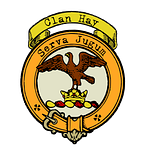Welcome back to "A Clan A Day Podcast" brought to you by bagtownclans.com. I’m your host, Colin MacDonald, and today, we’re exploring the incredible history of Clan Montgomery, a Lowland clan with deep Anglo-Norman roots that date back nearly a millennium. The story of the Montgomerys is filled with political intrigue, royal loyalties, bitter feuds, and a commitment to shaping both Scottish and English history. Their influence is felt not just across Scotland but in England, Wales, and even the United States.
The Montgomerys’ story begins in Normandy, where Roger de Montgomery, a powerful noble and key supporter of William the Conqueror, played a crucial role in the Norman Conquest of England in 1066. Roger, often called "The Great," was one of William’s most trusted allies. His son, another Roger, was joint Regent of Normandy while William focused on conquering England. Following the invasion, the Montgomerys were richly rewarded with vast lands. Roger was made the Earl of Arundel and later the Earl of Shrewsbury, cementing the family's presence in England. The county of Montgomery in Wales is named in his honor, a testament to the family's reach.
It was in the 12th century that the Montgomery name made its way to Scotland. Robert de Montgomerie, a descendant of Roger, was granted the lands of Eaglesham in Renfrewshire, which would become the heartland of the clan for centuries. Robert's family quickly established itself as one of the most influential in the region, particularly after John Montgomerie of Eaglesham captured Henry Percy, known as "Hotspur," at the Battle of Otterburn in 1388. The ransom paid for Percy enabled John to build Polnoon Castle and acquire the lands of Eglinton and Ardrossan through marriage, further cementing the Montgomery legacy.
The clan's rise to nobility was swift, and by the 15th century, Sir Alexander Montgomerie had been created the first Lord Montgomerie, a member of the King's council. His grandson, Hugh, would become the first Earl of Eglinton in 1507. Hugh played a crucial role in the political landscape of Scotland, aligning himself with those who opposed King James III at the Battle of Sauchieburn in 1488, where the king met his demise. Hugh was richly rewarded for his loyalty, receiving the Isle of Arran and control of Brodick Castle, significant strategic holdings in Scotland.
The Montgomerys’ influence continued through the turbulent times of the Scottish Reformation and the Wars of the Three Kingdoms. The second Earl of Eglinton was a staunch Catholic who fought for Mary, Queen of Scots, at the Battle of Langside in 1568, an allegiance that nearly destroyed him. Declared guilty of treason, he was imprisoned but later released, trying to broker tolerance for Catholics in post-Reformation Scotland. Ironically, his daughter, Lady Margaret, married Robert Seton, 1st Earl of Winton, a loyal Covenanter during the civil wars under Charles I, showing just how tangled loyalties could become during these chaotic times.
One of the most dramatic events in Montgomery history was the clan’s long-standing feud with the Cunninghams, one of the most bitter rivalries in Scotland. The feud peaked in the 16th century, with the burning of Eglinton Castle and the killing of the 4th Earl of Eglinton by the Cunninghams in 1586. In retaliation, the Montgomerys exacted their revenge, killing every Cunningham they could find. It took royal intervention to finally end this bloody conflict.
Despite these internal strifes, the Montgomerys continued to thrive. The 9th Earl of Eglinton was a prominent member of the Privy Council under King William and Queen Anne. His efforts in promoting the training of Ayrshire's fencible men during the Jacobite Rebellion of 1715 solidified his role as a defender of the realm. The 11th Earl raised the famous 77th Regiment of Foot, which played a key role in the British military during the Seven Years’ War and the early years of the American Revolutionary War.
The 13th Earl of Eglinton left a different kind of legacy, hosting the celebrated Eglinton Tournament in 1839. Designed as a romanticized recreation of medieval jousting, the event attracted attention from across Europe and was a symbol of the Victorian revival of chivalric ideals. Eglinton Castle, their ancestral home, was the center of this cultural spectacle.
Moving forward to modern times, perhaps the most famous Montgomery of all was Field Marshal Bernard Montgomery, 1st Viscount Montgomery of Alamein, a prominent British military leader during World War II. His leadership during the Battle of El Alamein, the Allied invasion of Normandy, and throughout the European theater cemented his place as one of the greatest military commanders of the 20th century. His legacy is immortalized not just in military history but in the many places across the world named after him, including Montgomery, Alabama, in the United States.
From their Norman origins to their role in shaping the political and military landscape of Scotland, England, and beyond, the Montgomerys have proven themselves a clan of enduring influence. Their story is one of resilience, loyalty, and the pursuit of power—both through force and diplomacy.
Thank you for joining us on this journey through the history of Clan Montgomery. Be sure to tune in tomorrow for another episode of "A Clan A Day Podcast." I’m your host, Colin MacDonald, and as always, Go n-éirí an bóthar leat!













Share this post